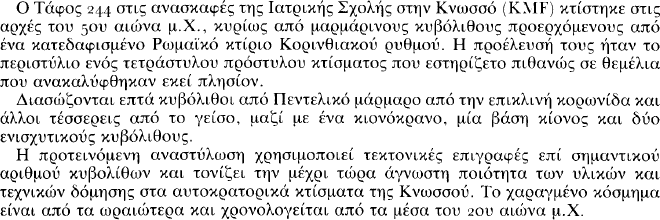No CrossRef data available.
Article contents
A Roman Corinthian Building at Knossos
Published online by Cambridge University Press: 27 September 2013
Abstract
Tomb 244 of the KMF excavation at Knossos was built in the early 5th century A.D., largely of marble blocks from a dismantled Roman Corinthian building. These came from the portico of a tetrastyle prostyle building which probably stood on a foundation discovered nearby. Seven blocks of Pentelic marble survive from the raking cornice and four more from the entablature, together with one capital, a column base and two backing blocks. The reconstruction proposed uses builders' inscriptions on several blocks and illustrates the hitherto unsuspected quality of Imperial building materials and techniques at Knossos. The carved ornament is of the finest and dates to the mid 2nd century A.D.

- Type
- Articles
- Information
- Copyright
- Copyright © The Council, British School at Athens 1991
References
Acknowledgements: I am very grateful to the Committee of the British School at Athens and to Dr H.W. Catling for permission to study this material. I would also like to thank Dr Ch. Kritsas, Director of the Heraklion Museum, and Dr Susan Walker for their advice, and David Parfitt who took all the photographs except plate 73c. I am grateful to many people who have kindly helped me, especially Dr J. Carington-Smith, Professor J.N. Coldstream Vronwy Hankey, A.H.S. Megaw, Dr C.E. Morris, Graham Norrie, Rose Parfitt, Mervyn Popham, Dr A.A.D. Peatfield, Guy Sanders, David Smyth and Dr K.A. Wardle.
1 Catling, H.W.: Knossos 1978, AR 1978–1979.Google Scholar
2 Megaw, A.H.S.: A Cemetery Church with Trefoil Sanctuary in Crete, Actes du Xe Congrès International d'Archeologie Ckrétienne, II, 1984.Google Scholar
3 I am very grateful to Dr Ch. Kritsas for his help in reading these inscriptions.
4 Gnoli, R.: Marmora Romana (Roma, 1971)Google Scholar; for cipollino, see Hankey, V., A Marble Quarry at Karystos, BMBery 18 1965) pp. 53–61.Google Scholar
5 The Roman foot is taken to be 0.296 m.
6 Vitruvius, : De Architecture, III, iii, 6.Google Scholar
7 5.32 ÷ cos 18.
8 5.32 × tan 18, plus 0.19 m for the height of the sima.
9 Pliny, : HN. XXXVI. lvi.Google Scholar
10 Jones, M. Wilson: Designing the Roman Corinthian Order, JRA 2 (1989) pp. 35–69.Google Scholar
11 Ward-Perkins, J.B.: Quarrying in Antiquity. Proc.Br.Ac. 57 (1971) pp. 137–58Google Scholar: Nicomedia, and the Marble Trade. BSR 35 (1980), pp. 23–69.Google Scholar
12 Vitruvius: III, iii. 10.
13 I am not an epigraphist and do not know of any close parallels for these inscriptions, but since they clearly relate to the construction of the building it seems best to publish them here as they stand.
14 Orlandos, A. and Travlos, J.Lexicon of Ancient Architectural terms Athens 1986 (in Greek).Google Scholar
15 LSJ 9 Κανϑήλια = a pack-saddle.
16 The inscription on 2. ΕYΩΝYΜΟΣΠΑΡΑ ΚΑΝΘΗΛΙΑΙΟΝ was not discovered until 1989. some time after the position of the block, on the left next to the apex, had been established.
17 A.H.S. Megaw: A Cemetery Church with Trefoil Sanctuary in Crete.
18 I.F. Sanders: Roman Crete (1482).
19 ÖJh 44 (1959). 264–6.
20 Forschungen in Ephesos V. 2 (1953).
21 Heilmeyer, W-D: Korinthische Normalkapitellc. AM 1970Google Scholar (Corinth, Taf. 5. 13 and 15: Athens. Taf. 17.)
22 Forschungen in Ephesos, V, 2 (1953). Plate 50.
23 Akurgal, Ekrem: Griechische und Römische Kunst in der Türkei (1987) Plate 222Google Scholar: Heilmcyer. Taf. 38, no. 1.
24 Heilmeyer, Taf. 26. no. 5, Taf. 27. no. 1; Strong, D.E., Late Hadrianic Architectural Ornament in Rome BSR 21 (1953). 118–151.Google Scholar
25 Forschungen in Ephesos. V, 2. (1953), Plate 23.
26 Heilmeyer, Taf. 33, no. 2. Proconnesian capitals with similar ornament on the abacus come from the Severan Forum at Lepcis Magna (Heilmeyer, Taf. 33. No. 4), and the Agora at Smyrna (Ward-Perkins, J.B., Nicomedia and the Marble Trade, BSR, 35 1980, Plate XVII).Google Scholar
27 Nicomedia and the Marble Trade.
28 Sanders, I.F., Roman Crete (1982), Plate 36.Google Scholar
29 Roman Crete, Plate 23.
30 Nicomedia and the Marble Trade, p. 49.
31 Roman Crete, 69–70; Sinclair Hood and David Smyth: Archaeological Survey of the Knossos Area no. 114.
32 A.H.S. Megaw: A Cemetery Church with Trefoil Sanctuary in Crete, 326.




